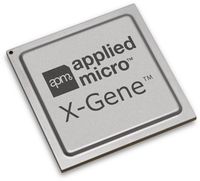(Created page with "{{apm title|X-Gene}} {{ic family | title = X-Gene | image = x-gene_front.jpg | caption = | no image = | developer = Applie...") |
|||
| Line 31: | Line 31: | ||
| successor link = ampere computing/emag | | successor link = ampere computing/emag | ||
}} | }} | ||
| − | '''X-Gene''' | + | '''X-Gene''' was a family of {{arch|64}} [[ARM]] server microprocessors designed and introduced by [[AppliedMicro]]. |
| + | |||
| + | == Overview == | ||
| + | X-Gene was a family of high-performance multi-core ARM microprocessors first announced by [[AppliedMicro]] in 2011. Unlike their traditional product offering, X-Gene directly targeted high-performance data center servers, a market predominantly dominated by [[Intel]] {{intel|Xeon}} processors. AppliedMicro introduced two generations of server processors based on their own custom [[ARM]] microarchitectures - {{apm|Storm|l=arch}} and {{apm|Shadowcat|l=arch}}. Those two generations shipped a total of 25,000 units. In late [[2016]], [[MACOM]] acquired AppliedMicro resulting in the shelving of third-generation X-Gene based on the {{apm|Skylake|l=arch}} microarchitecture. The X-Gene [[intellectual property]] including most of the design team was eventually sold to [[Ampere Computing]] has rebranded the design and improved on it under the {{ampere|eMAG}} brand. | ||
| + | |||
| + | == Members == | ||
| + | === X-Gene 1 === | ||
| + | {{empty section}} | ||
| + | |||
| + | === X-Gene 2 === | ||
| + | {{empty section}} | ||
| + | |||
| + | === X-Gene 3 === | ||
| + | {{empty section}} | ||
| + | |||
| + | == See also == | ||
| + | * Cavium {{cavium|ThunderX2}} | ||
| + | * Qualcomm {{qualcomm|Centriq}} | ||
| + | |||
| + | == Bibliography == | ||
| + | * David Schor. (February 5, 2018). "''[https://fuse.wikichip.org/news/776/x-gene-3-gets-a-second-chance-at-ampere-with-a-new-32-core-16nm-arm-processor/ X-Gene 3 gets a second chance at Ampere with a new 32-core 16nm ARM processor]''". | ||
Revision as of 14:55, 23 September 2018
| X-Gene | |

| |
| Developer | AppliedMicro |
| Manufacturer | TSMC |
| Type | Microprocessors |
| Introduction | October 28, 2011 (announced) 2012 (launch) |
| ISA | ARM |
| µarch | Storm, Shadowcat, Skylark |
| Word size | 64 bit 8 octets
16 nibbles |
| Process | 40 nm 0.04 μm , 28 nm4.0e-5 mm 0.028 μm , 16 nm2.8e-5 mm 0.016 μm
1.6e-5 mm |
| Technology | CMOS |
| Clock | 2.4 GHz-3.3 GHz |
| Succession | |
| → | |
| eMAG | |
X-Gene was a family of 64-bit ARM server microprocessors designed and introduced by AppliedMicro.
Overview
X-Gene was a family of high-performance multi-core ARM microprocessors first announced by AppliedMicro in 2011. Unlike their traditional product offering, X-Gene directly targeted high-performance data center servers, a market predominantly dominated by Intel Xeon processors. AppliedMicro introduced two generations of server processors based on their own custom ARM microarchitectures - Storm and Shadowcat. Those two generations shipped a total of 25,000 units. In late 2016, MACOM acquired AppliedMicro resulting in the shelving of third-generation X-Gene based on the Skylake microarchitecture. The X-Gene intellectual property including most of the design team was eventually sold to Ampere Computing has rebranded the design and improved on it under the eMAG brand.
Members
X-Gene 1
| This section is empty; you can help add the missing info by editing this page. |
X-Gene 2
| This section is empty; you can help add the missing info by editing this page. |
X-Gene 3
| This section is empty; you can help add the missing info by editing this page. |
See also
Bibliography
- David Schor. (February 5, 2018). "X-Gene 3 gets a second chance at Ampere with a new 32-core 16nm ARM processor".
| designer | AppliedMicro + |
| first announced | October 28, 2011 + |
| first launched | 2012 + |
| full page name | apm/x-gene + |
| instance of | microprocessor family + |
| instruction set architecture | ARM + |
| main designer | AppliedMicro + |
| manufacturer | TSMC + |
| microarchitecture | Storm +, Shadowcat + and Skylark + |
| name | X-Gene + |
| process | 40 nm (0.04 μm, 4.0e-5 mm) +, 28 nm (0.028 μm, 2.8e-5 mm) + and 16 nm (0.016 μm, 1.6e-5 mm) + |
| technology | CMOS + |
| word size | 64 bit (8 octets, 16 nibbles) + |